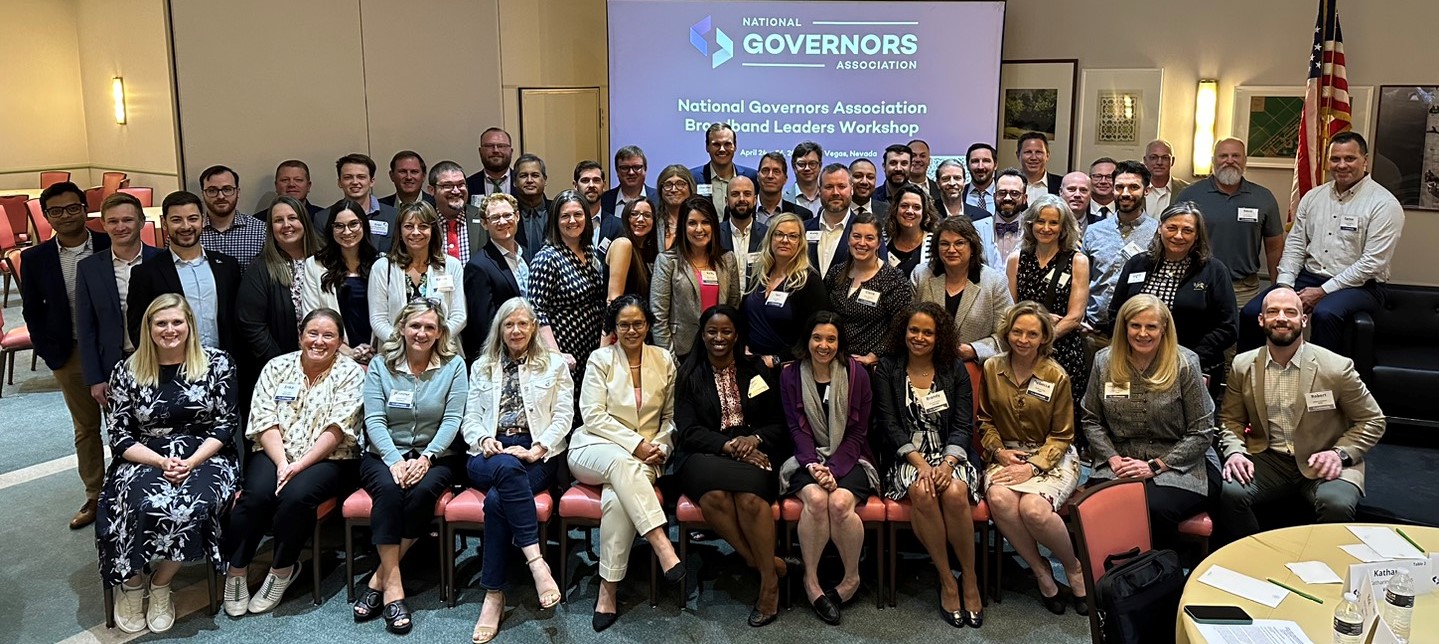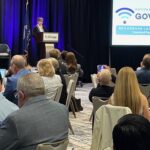
Broadband
Fast reliable broadband is the backbone of the modern economy and is essential for the education, health, and wellbeing of individuals, households, and communities. As Governors implement generational broadband infrastructure funding to support access, affordability, and adoption of high-speed internet, this page will serve to promote their work and highlight developments in the public and private sector.
NGA Resources

Building for Tomorrow: Governors Showcase Infrastructure Investment in State of the State Addresses

NGA Wraps Up Third Broadband Leaders Workshop in Kansas

Governors Implement: On the Road to Infrastructure in Kansas (Part II)

Expanding the Broadband Workforce: How Three States are Preparing for Equitable Broadband Deployment

Broadband Leaders Workshop
Featured
IIJA Implementation Resources

As Governors lead on implementing the historic bipartisan Infrastructure Investment and Jobs Act (IIJA) and other state and federal infrastructure measures, the National Governors Association will be continuing to provide timely and actionable resources, create opportunities for Governors and their staff to convene and collaborate, and maintain relationships with critical federal, state, local, and private sector stakeholders. This page serves as a one stop shop for information on all these efforts. Learn more…
Digital Access And Skill Development
As Governors lead efforts to promote equitable and forward-looking economic recovery in their states and territories, the Workforce Innovation Network helps facilitate innovative state-level policy solutions that improve employment and workforce outcomes. Learn more…
Infrastructure Insights
NGA has collated a variety of resources to leverage the expertise of NGA partners to provide insights to assist with delivering specific program areas and cross-program tools and best practices. Learn more…
Federal Updates
- NTIA releases Final Alternative Broadband Technology Policy Notice – January 3, 2025
- NTIA releases new version of Final Proposal Guidance and Accelerating Construction of BEAD Guidance – December 23, 2024
- NTIA announces Regional Roundtables on Broadband Program Sustainability – December 19, 2024
- FCC Announces Effective Date for Pole Attachment Access Rules – July 26, 2024
- NTIA Announces Availability and Individual State and Territory Allocations under the Digital Equity Capacity Grants Program (March 29, 2024)
- FCC releases Broadband Consumer Label Requirements for Internet Service Providers (March 19, 2024)
- Federal Communication Commission releases latest version of the National Broadband Map – see statement from Chairwoman Rosenworcel here (November 17, 2023)
- NTIA’s programmatic waiver of the Letter of Credit Requirements in the BEAD Notice of Funding Opportunity (November 1, 2023)
- NTIA’s BEAD Initial Proposal Funding Request (IPFR) Guidance (October 2023)
- U.S. Department of Treasury’s Compliance and Reporting Guidance for the Capital Project Fund (September 18, 2023)
- FCC’s New E-ACAM Support to Expand Broadband to Rural Communities (August 30, 2023)
- NTIA’s Draft Waiver of Buy America Domestic Content Procurements Preference for BEAD Program (August 22, 2023)
- NTIA Announces Broadband Equity, Access and Deployment (BEAD) allocations to states and territories and Sets Deadline for Initial Proposals for December 27, 2023 (June 26, 2023)
- NTIA’s Final Guidance and a Model Process for the BEAD Program’s State Challenge Process (June 2023)
- NTIA’s Public Notice Posting of State and Territory BEAD and Digital Equity Plans/Proposals
- Federal Communications Commission’s Broadband Map Version 2
- Internet for All webpage
- White House Get Internet site for the Affordable Connectivity Program
- NTIA’s Middle Mile Build America Buy America Waiver
- NTIA’s resource providing a complete list of all federal resources for which broadband is an eligible expense
- Federal Highway Administration – Final Rule – Broadband Infrastructure Deployment
Broadband Federal Funding Programs
The federal government administers several programs through various agencies to fund investment in broadband infrastructure access, affordability and adoption. The table below includes programs in the Infrastructure Investment and Jobs Act, those that were created in response to the COVID-19 pandemic and previously-existing programs administered annually. This resource covers federal funding grant programs that have a discreet allocation of funding and are distributed to state and local governments, the private sector, anchor and health care institutions, and directly to the public. Additional federal support may be provided as an eligible reimbursement within other programs and formula funding sources, but these are not included below.
Terms/Abbreviations
| Coronavirus Aid, Relief and Economic Security Act | CARES Act |
| Coronavirus Response and Relief Supplemental Appropriations Act | CRRSA |
| Federal Communications Commission | FCC |
| Internet Service Provider | ISP |
| National Telecommunications and Information Administration | NTIA |
| Rural Utilities Service | RUS |
| U.S. Department of Agriculture | USDA |
| U.S. Department of Commerce | Commerce |
| U.S. Department of Education | Education |
| U.S. Department of Housing and Urban Development | HUD |
| U.S. Department of the Treasury | Treasury |
| Universal Service Fund | USF |
Updated: April 15, 2024
| Agency / Branch | Program Name | Program Description | Total Funding | Individual Funding Awards | Eligible Recipients | Program Type | Latest milestone |
|---|---|---|---|---|---|---|---|
| USDA – RUS | Reconnect Loans and Grants (Rural eConnectivity program) | Provides loans, grants and loan/grant combinations to facilitate broadband deployment in rural areas. Funding can be used for cost of construction, improvement, or acquisition of facilities and equipment needed to facilitate broadband deployment in rural areas. | $2 billion FY2022-2026 (IIJA) | The maximum amount that can be requested is $25 million for the loan and $25 million for the grant. | States or Local governments, Territories or Possessions of The United States, Tribes, Private business | Existing Program now supported by IIJA Funding | April 22, 2024 - Applications closed for Broadband ReConnect Program Round Five |
| USDA – RUS | Distance Learning and Telemedicine Grants | To assist rural communities in acquiring distance learning and telemedical technologies so that local teachers and medical service providers who serve rural residents can link to other teachers, medical providers and experts. | $60 million for FY2024 | $50,000 to $1 million | States, local governments, tribes, non-profit organizations, for-profit businesses | Competitive | April 29, 2024 - Applications closed for FY2024 |
| USDA- RUS | Community Connect Grant (CCG) Program | Grant funds will be made available to eligible applicants to construct broadband networks that provide service on a community-oriented connectivity basis in rural areas. | $79 million for FY2023 | States, Local Governments, Tribes, Incorporated organization | Competitive | February 20, 2024 - Applications closed (deadline extended) | |
| FCC – USF | Lifeline – Low Income | Assists low income individuals to help pay phone and broadband charges | Universal Service Fund | Allocates $9.25 per household discount for wireline or wireless service support per month | Consumer Direct | Existing Program | Applications for consumers open on an ongoing basis |
| FCC – USF | Schools and Libraries – E-rate | Eligible schools and libraries receive discounts on costs of telecommunications services | Universal Service Fund | Discounts range from 20 to 90 percent, based on the poverty level of the school, with rural schools and libraries potentially receiving higher discounts | K-12, Library | Existing Program | Ongoing |
| FCC – USF | Rural Health Care | Reduces costs for rural health care providers to make telecommunication services more competitive with urban provider costs | Universal Service Fund | Eligible providers may receive a 65% flat discount on broadband services | Rural health care providers, including schools, community care centers, local health depts | Existing Program | April 1, 2024 - Filing window closed for FY24 funding |
| FCC - USF | High Cost Program - Connect America Fund | To deliver affordable voice and broadband service in rural areas that would otherwise be unserved or undeserved. | Universal Service Fund | Eligible Telecommunication Carriers | Existing | August 21, 2018 - Phase II auction closed | |
| FCC | Rural Digital Opportunity Fund (RDOF) | A two phase competitive reverse auction to ensure the deployment of robust, sustainable high speed networks in rural areas | $20.4 billion over 10 years | ISPs | Existing Program | Phase I completed. | |
| FCC | 5G Fund for Rural America | Deploying 5G services to eligible rural communities | ISPs | Existing Program | |||
| FCC | Affordable Connectivity Program | Provides discounts to eligible low-income families on broadband services | $14.2 billion (IIJA) | $30 monthly benefit on a monthly internet bill. Up to $75 for low-income households on Tribal lands. | Individual Families | Existing program | Program no longer in operation |
| FCC | Affordable Connectivity Program - Outreach Grants | To raise awareness about the Affordable Connectivity Program | $100 million (IIJA) | Maximum of $400,000 | Individual Families | Existing program | Affordable Connectivity Program no longer in operation |
| FCC | Emergency Connectivity Fund | Provides funding to schools and libraries for laptops, Wi-Fi hotspots or other internet devices to ensure students have the necessary support to keep up with their education. | $7.17 billion (ARPA) | Reimburses 100% of the costs to purchase eligible internet equipment for a school or library. | Libraries and Schools | New | 2023 - Awards announced from round 3, which closed May 2022 |
| NTIA | Tribal Broadband Connectivity Grants | The Tribal Broadband Connectivity Program provides grants for broadband infrastructure deployment; affordable broadband programs; distance learning, telehealth, digital inclusion efforts; and broadband adoption activities. | $2 billion funding (IIJA) | Tribal governments and other eligible entities can apply for funding, with grant awards between $50,000 and $50 million. | Tribal Governments, Tribal organizations, Tribal Colleges or Universities, the Department of Hawaiian Home Lands on behalf of the Native Hawaiian Community, and Alaska Native Corporations. | Covid program extended through IIJA funding | January 23, 2024 - Applications closed for second round funding of Tribal Broadband Connectivity Program |
| NTIA | Connecting Minority Communities Pilot Program | For to Historically Black Colleges and Universities (HBCUs), Tribal Colleges and Universities (TCUs), and Minority-Serving Institutions (MSIs) for the purchase of broadband internet access service and eligible equipment or to hire and train information technology personnel. | $285 million (CRRSA) | This program provides grants directly to students to pay for internet services or equipment. | Schools | New COVID Program | In post-award phase period |
| NTIA | Broadband Equity, Access, and Deployment Program | Provides $42.45 billion to expand high-speed internet access by funding planning, infrastructure deployment and adoption programs. | $42.45 billion FY2022-FY2026 (IIJA) | $100M to each State, D.C., and Puerto Rico $25M to each other territory $4.245B to "high cost areas" distributed by formula $37.1B distributed by formula based on new FCC maps | States and Territories | New IIJA formula program | NTIA in process of approving Initial Proposal documents |
| NTIA | State Digital Equity Planning Grant Program | The State Digital Equity Planning Grant Program is a $60 million formula grant program for States and territories to develop digital equity plans. | $60 million (IIJA) | $60 million formula grant for states to develop a digital equity plan. | States, Territories and Tribal governments | New IIJA formula program | March 29, 2024 - NTIA announced availability and individual state and territory allocations |
| NTIA | State Digital Equity Capacity Grant Program | The State Digital Equity Capacity Grant Program dedicates a $1.44 billion formula grant program for States, Territories, Tribal governments, Alaska Native entities, Native Hawaiian organizations distributed via annual grant programs over five years to implement digital equity projects and support the implementation of digital equity plans. | $1.44 billion (IIJA) | Amounts determined via formula | States, Territories, Tribal governments, Alaska Native entities, Native Hawaiian organizations | New IIJA Formula program | May 28, 2024 - Applications closed for State Digital Equity Capacity Grant Program for states and Puerto Rico; July 31, 2024 - Applications closed for State Digital Equity Capacity Grant Program for Territories (other than PR) |
| NTIA | Enabling Middle Mile Broadband Infrastructure Program | Grant program to expand and extend middle mile infrastructure and reduce costs of connecting unserved and underserved communities. | $1 billion (IIJA) | Awards expected to be between $5 million to $100 million. | States and Territories, Tribes, ISPs, and local entities | New IIJA competitive program | June 16, 2023 - Awards Announced |
| NTIA | Digital Equity Competitive Grant Program | The Digital Equity Competitive Grant Program is a $1.25 billion discretionary grant program distributed via annual grant programs over five years to implement digital equity projects. | $1.25 billion (IIJA) | Unknown | Local Education Agency; State Governments, including any political subdivisions of the State; Tribal/Native American Governments; Alaska Native Entities; and Native Hawaiian Organizations, Non-Profit Organizations; Community Anchor Institutions; and Workforce Development Programs | New IIJA competitive grant program | NOFO open - applications for states and Puerto Rico close September 23, 2024 and for other territories on October 22, 2024 |
| Treasury | Capital Projects Fund | To help ensure that all communities have access to the high-quality modern infrastructure, including broadband, needed to access critical services | $10 billion (ARP) | States/Local, Tribe | COVID program in American Rescue Plan Act | Award announcements on a rolling basis | |
| Treasury | Coronavirus State and Local Fiscal Recovery Fund | The ARP provided flexible funding to states to aid economic impacts, including in broadband infrastructure. | $350 billion (ARP) | Interim final rule published | States/Local, Tribes | New COVID Program | Available |
| USDA | Broadband Technical Assistance Program | Provides financial assistance through cooperative agreements to eligible entities to receive or deliver broadband technical assistance and training and supports the development and expansion of broadband cooperatives. | $20 million for latest funding round | Up to $1 million | States, territories, Tribes, local governments, institutions of higher ed., nonprofits, corporations etc. | Competitive | August 20, 2024 - Applications closed |
| Delta Regional Authority | Delta Regional Authority - States Economic Development Program | Provides direct investment into community based projects, 75 percent of which must go to economically distressed counties and parishes. Half of these funds must be allocated to basic public infrastructure which includes broadband. | States receive formula funding to be designated for eligible projects meeting program criteria. | 8 states in Delta region | Existing Program | Program renewed annually. | |
| Delta Regional Authority | Delta Regional Authority - Community Infrastructure Fund | Targets physical infrastructure projects to build more resilient communities in the region. Investments include basic public infrastructure development such as broadband. | States receive formula balance to be designated for eligible projects meeting program criteria. | 8 states in Delta region | Existing Program | Annual Rolling Cycle | |
| Appalachian Regional Commission | Area Development Program | Makes investments in critical infrastructure and business and workforce development. Broadband is a prioirity investment area withing the critical infrastrucutre investments. | Applicants should reach out to state grant managers. Matches are required and vary by counties' economic status. | 13 States in Appalachian Region | Existing Program | Program renewed annually | |
| Appalachian Regional Commission | READY Appalachia - Community Capacity Building | Offers flexible funding to organizations in four economic pillars: nonprofits, local governments, community foundations and local development districts, and free workforce training. | Nonprofits, community foundations, local development districts and local governments. | New Program | Varies | ||
| Appalachian Regional Commission | Appalachian Regional Initiative for Stronger Economies (ARISE) | To drive large-scale, regional economic transformation through multi-state collaborative projects across Appalachia | $80 million | $10 million maximum for implementation grants, $500,000 maximum for planning grants | States, counties, cities, local development districts, institutions of higher education, public or private nonprofit organizations or associations | Competitive |
